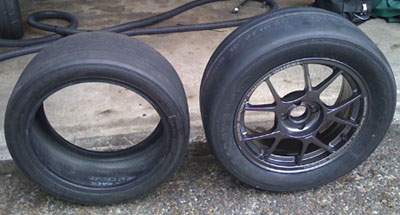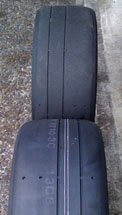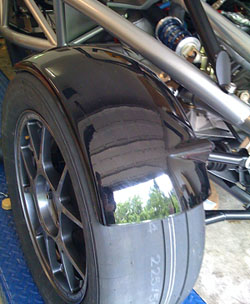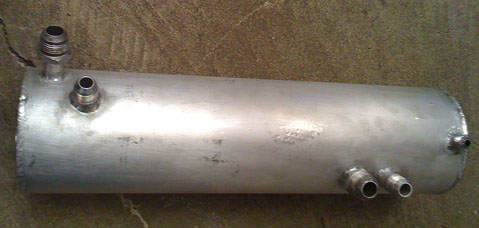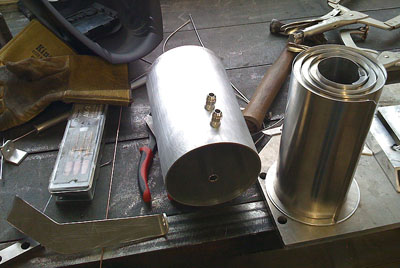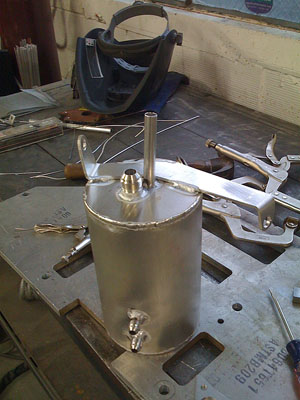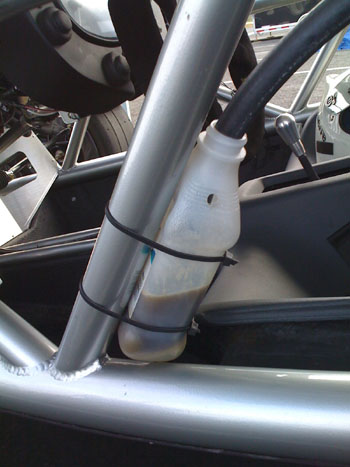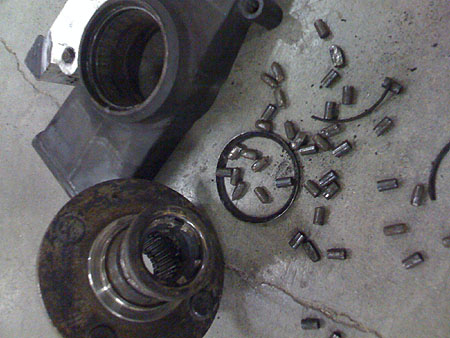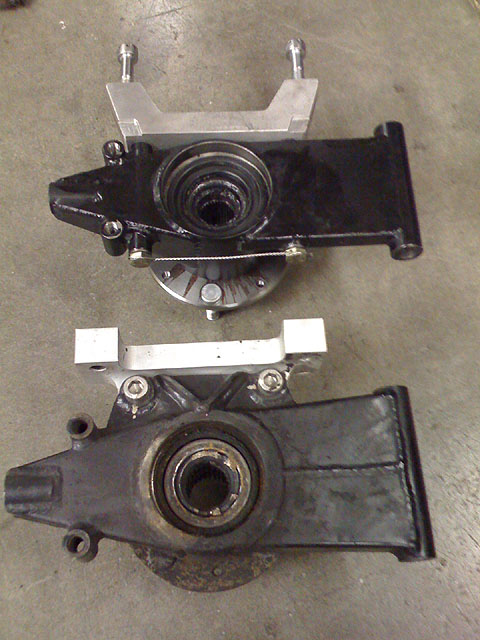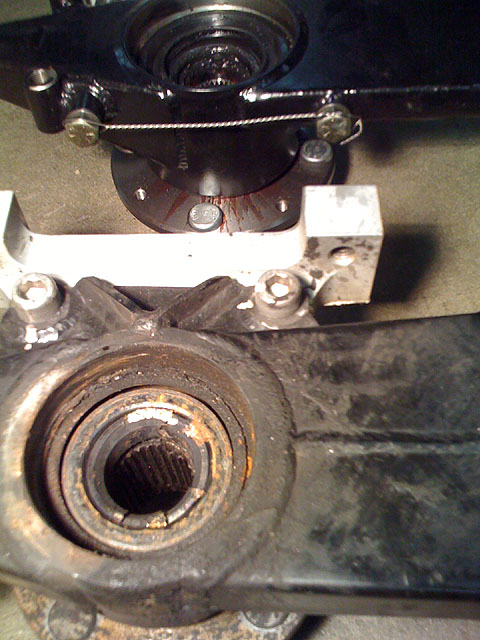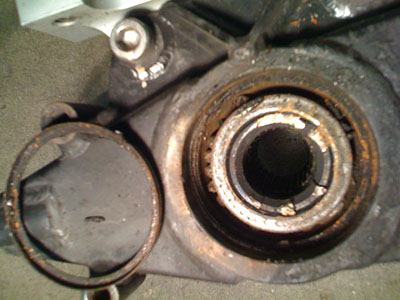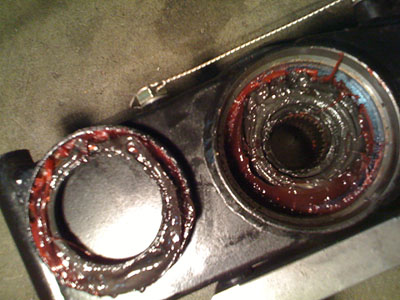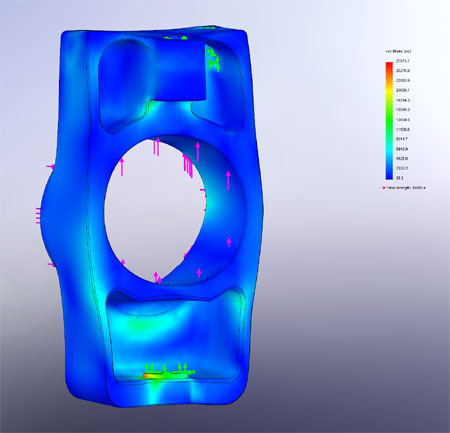|
08/21/08 The next test of the oiling system is coming up (25th if it doesn't rain and 29th regardless). In the meantime, a number of other things need taking care of. The new dash is on the way so I guess the old one is for sale - if someone wants a 9K RPM SPA dash with 0 miles on it (haven't hooked up the speedo yet), let me know. It's basically brand new. Retail is $1,400 but I'm willing to consider offers - email me. It'll come with whatever the new one comes with since the wiring is already in the car. The one thing that I did take care of was get bigger tires for the back. Testing showed that taller gearing would be beneficial, as would more rubber on the road! I ended up getting 225/50-16 in place of the 215/40-16 that I had on the car before (the fronts remain the smaller size). Diameter goes up from 22.6" to 24.7". It is the biggest tire that will fit on the existing wheels and also the biggest that will fit with the stock fenders - barely! Even after adjusting the fenders to their topmost position there is only about 1/4" clearance. Typical for this car it seems.
The new tires raise rear ride height 1" which is not necessarily bad. It does raise the CG but also provides more ground clearance under the engine and gives the car some rake overall which may add downforce - or not. Brake bias is also affected somewhat (shifted towards the front). I'm going to leave the ride height as-is for now and see how it works, then tweak from there if need be.
08/23/08 Making more progress on getting Bikini trackworthy. The new dash won't be here till tuesday but there's still lots I can do. First, I extended the exhaust tips so that the paint on the frame doesn't get fried. I figured everything out and made the parts, Jared welded them up.
Next was the installation of a catch tank - in case either oil or coolant overflow, I need a catch tank to gather the errant fluids. Ended up fabricating it from parts of many different things, with a spare brake reservoir doing the duty of the tank itself. Turned out OK and it even fits under the cover - barely. Had to move the breather filter forward but that's for the better anyway.
The tank even has a neat drain valve at the bottom. Tomorrow is some wiring and installing an oil temp gauge in place of the now redundant secondary oil pressure gauge. Then Bikini should be ready for the next test. Monday is BMW day but they are promising rain so I may or may not bring the Atom to that one. Friday is Lotus day and supposedly sunny so that's the primary target. And I'll try to get the dp1 proto ready for that one too (see its page). 09/17/08 The last track outing was so frustrating that I didin't even bother to do an update for Bikini (see dp1 entry for 08/29). The oil problem got considerably worse, not better. Upon some reflection I came to the conclusion that the most likely cause of this was my attempt to connect the drain for the vent tube to one of the scavenge lines. I was counting on oil flow creating a bit of a venturi effect but it seems that most of what's coming out is foam. If there is a lot of foam being pushed through the scavenge line there is no hope for venturi of any kind, but more likely the foam will take the less-resistance path up the vent tube instead of into the tank. So as near as I can tell this is what was happening. John Hartley thought this might be the case and turns out he was right. IF this is the real root of the problem, of course. The proposed fix? - to drain the vent tube low in the tank, below the foam line, but still above the oil pickup to reduce the chance of it introducing air at the wrong moment. So I took everything apart again, took the tank out, cleaned it, welded yet another fitting on and reinstalled it back in the car. The fittings are definitely multiplying.
I also took the extra steps of draining all the oil from the cooler and the lines, as well as changed the filter. I sent off a sample of the oil to Blackstone Labs for analysis so we'll see what the report says. With everything buttoned up, new oil went in. I warmed it up and revved to 10K a few times. No spillage so far but of course it's the cornering I have to watch. I've been thinking of tilting the car while stationary to simulate lateral g and a few other people have suggested it also. If I had an engine hoist it would be fairly straightforward but I no longer have access to one. Maybe I'll borrow it for a couple days. Or, I could just wait till Monday for the next trackday and risk frustration once more. If this fix doesn't work it will take me some time to figure out the next step and therefore it probably wouldn't be ready for Monday anyway... So I might justify my procrastination thusly :) OK, I actually have tons of other things to do so maybe it's a good balance of getting them done and still at least attempting progress on the oil issue. We'll see. UPDATE: Got the results of the oil analysis - everything looks good. Nice to know that some things are still going OK :) 09/22/08 No, it still doesn't work. But at least I'm closer to a solution so despite only having gotten 3 laps in the whole trackday I actually feel OK about it (I also instructed so it wasn't a waste). Basically, the first half of a lap produced a cloud of smoke, telling me that changing the drain point to the bottom of the oil tank had no effect. The stuff that comes out is foam that looks like this:
It stays this way for a long time (tens of minutes). It is quite possible that there is some condensation in the oil so maybe if I warm the engine more thoroughly before flogging it the foaming would be less. But basically what is happening is that a portion of the oil turns into foam and pushes out of the tank so that is why all my various labyrinth and baffling attempts haven't worked. It is not the g-forces that do it, but the volume of blow-by gases resulting from continuous operation at high power levels, producing foam that just has to go somewhere. Duplicating this on the street is going to be impossible. Dyno - maybe. Therefore what John Hartley has been saying about the need for more volume appears to be true. The solution would be to create a second tank where foam could go and hopefully convert back to oil, given enough time. The main tank is 6L in capacity, 4 of which is oil and as it turns out the other 2L are just not enough for the volume of foam created. So as a quick fix I called Jared and asked him to fabricate a 4" tall can out of the same tube that the main tank is made of. This would make a 1L external reservoir. He did it in a couple of hours and over lunch I picked it up and installed it, replacing the vent tube I had before.
The effect of the change was to delay oil spillage considerably. I did two full laps and when I came in the oil only started pushing into the overflow catch can and hadn't gone all over the engine yet. Man, this thing is fun when I can actually drive it! Gotta find the fnal fix. Soon. The current plan is to see where I can fit about a 3-4L tank. I want to increase main tank oil volume to 5L leaving 1L for foam plus whatever the external tank holds. It has been suggested by several people that I should just put the foam reservoir behind the driver's head. I may end up doing that though I would really rather avoid it. Maybe this obscession with keeping the engine installation confined to the engine bay is what's causing my problems but that's part of the challenge of this project. If it were easy anyone could do it (as it is, Brammo tried and failed and I don't believe that the factory v8 Atom really exists, so as far as I know this is the only running v8 Atom in the world). I want it to be clean and not some Mad Max mobile with stuff hanging all over the place. Anyway it's a good exercise and learning experience (OK, often it's mostly an exercise in frustration). 10/02/08 Time slithers right along and trackday opportunities left in the year are few indeed. Nevertheless, I have to just keep moving. Hopefully I'll get to test the latest fix yet this year. And it is this:
The de-aeration tank is roughly 8" tall and has a fancy spiral gadget in it, another attempt to answer the question 'how do I get air to part company with the oil'. Along with some other trickery. The scroll of aluminum is a full 3 feet long. Should be plenty of wall area (6 feet in all because both sides are wetted) to get those air bubbles out. Took quite a bit of design and fabrication. Seriously, if this doesn't do it I don't know what will (well OK I do - a tank of at least twice the volume, sometimes the obvious is hard to accept). By the way, many thanks to everyone who has written me (and more) on the subject. I think this is the most response I've had in all the years I've been posting my trials and tribulations. Next is installing and actually testing the contraption. If it works, my future oil tank designs will be shaped by this. Otherwise not. 10/14/08 (updated 10/16) Nope, it still doesn't work. But I did did learn a few things today which are quire useful so as a test it was valuable. This time I mounted a clear catch can where I can seet while driving (should have done it earlier, really).
The main thing I learned is that oil only comes out on the straights under full power, over 7K RPM. So it's not the cornering which is causing the problem and therefore initially I was chasing the wrong solution with the baffles and such. Also what comes out now is not foam but pretty much solid oil. As John had reminded me, just one psi of pressure will push oil 34 inches up. Since the final outlet on the de-aerator tank is only 15" above oil level in the main tank, it only takes 1/2 psi of back pressure in the vent line between the two tanks to push the oil up the drain tube and outside. Which is exactly what seems to be happening. So the next fix to try would be a much bigger vent line (a -12 instead of a current -6, also bigger than the -10 drain tube) and removal of the aluminum mesh screen in the de-aerator tank that I put in there in an effort to help de-foaming. Those changes may or may not fix the issue since after all that I'm still only able to run 4 quarts of oil in the tank where it ideally should be at least 8. But it's worth a try just for education if nothing else. I'm now also trying to figure out where I can squeeze in a tank twice the size of the current one. Another item of note is that oil temp never comes up above 180 so the oil cooler I have may not be needed, but a second water radiator might be helpful. So another change I may do over the winter is modify the cooling systems accordingly. The good news is that whatever solutions I come up with can be tested on a dyno over the winter, no need for taking it out on the track (although as an instructor my track time is cheaper than dyno time). This also means that my dp1 tank design can be tested by John on his engine dyno during initial run-in, before the engine is shipped to me. And that is a very good thing. This finding alone is worth all the hassles I've been through so far. Which is exacly why Bikini is the testbed for the engine, I can deal with powertrain issues without worrying about the chassis so that in the dp1 I can then deal with the chassis without worrying about the powertrain. Therefore things are actually working according to plan, albeit much slower and less smoothly than hoped for. But, as I always say, if it were easy then anyone could do it :) UPDATE: A reader sent me a link to a very helpful article (thanks, Pierre!). It deals with crankcase vent system design and talks about the volume of blow-by gases. According to the article, the worst case blow-by volume can be as high as 3% (on overrun from high rpm, which coinsides with my observation that there is a surge of gas out the vent after lifting off the throttle - it didn't intuitively make sense but now it does). For a 2.8L engine spinning at 10K rpm this could amount to as much as 420 liters per minute (that's roughly 7 quarts per second)! In reality it is likely less than that but probably not far off. Of course all this stuff gets sucked out by the scavenge pump and pushed into the drysump tank, then it has to come out the vent. Really puts my choice of a -6 (3/8" diameter) vent line in perspective and makes it look pretty ridiculous. Live and learn. I now need to plan out my winter experiments, on this and other fronts. As of today I officially have added motivation due to some business developments - but more on that later, when all is said and done. 01/13/09 The big winter plan for Bikini is to take it all apart, fix the half-fixes all the way, and put it back together right. The list: 1. proper size oil tank 2. new fuel tank, or better yet a proper fuel cell 3. chassis bracing 4. upgraded engine mounts 5. tidied electricals 6. fixed uprights. On the latter bit, there's been a lot of talk on the Atom forum about failed bearings, twisted uprights, broken drive flanges, etc. So I did some research (and even got my hands on one such failed part to see for myself).
In attempting to press the failed bearing out of the upright I got, I had a first-hand demonstration in just how flimsy these things are - i.e. I mangled it badly. Someone had mentioned this to me in an email before but I guess I failed to appreciate the extent of the issue - I mean they LOOK OK, generally speaking. Well, I either owe a new upright or a discount on a proper replacement. Having both the UK and US versions in hand is instructional. Neither is perfect (or even good, in my humble opinion), but each has its tradeoffs.
Both use unsealed bearings. The seals are non-existent in the UK version and their lack likely had a lot to do with the failure - there's no trace of lubrication in the bearing, or what's left of it. The US one is better in having actual seals but they're not very well seated and all four of my wheels are spitting grease onto the brake rotors with only a couple hundred miles on the clock.
So I talked to several people who've designed, built and run racecars in the same general weight class (but a lot faster). The concensus is that it's not so much the bearing but how it's used - tolerances, preload, heat considerations (from brakes) all make a huge difference. From all that data I know what a proper upright should look like. Without giving too much away, here's a picture of a simplified FEA run with 2,000 lbs in each vertical, horizontal and lateral directions applied to it (no it's not the Atom upright but close):
The result of all this? I will be offering an upgrade kit (sorely needed in my opinion) for both UK and US Atoms. It'll be available in about 6 weeks and pricing will be announced later but it'll be very competitive with stock replacement parts (which I think are way overpriced for what they are). There are of course still issues related to undersized pushrod bearings and a whole host of other things. Some of them I will do upgrades for. But the ultimate solution? Well, keep checking for news on dp2 and dp3... :) |
